A Framework for Connecting Food, Culture & Health through Children’s Literature
Natalie K. DeWitt and Marie A. LeJeune
As health (Natalie) and literacy (Marie) educators, we both understand the critical roles that community and culture play within K-12 classrooms and beyond. In fact, we first met while involved in service learning projects that linked K-12 and college classrooms for food and spice drives to fund local food bank efforts within our small community. Food drives and other efforts to support food banks and access to food are an important part of our local and college culture. Our community is not alone in this respect. Food is something that unites communities but also that is driven by complex issues related to economics, health, culture, and geography.
Teaching nutrition concepts is commonplace in most elementary classrooms even though nutrition-specific standards or performance indicators do not exist within national K-12 health standards (Joint Committee on National Health Education Standards, 2007). Classroom teachers can choose any content area that is relevant to their students to teach general health-related skill building. More often than not, educators choose nutrition-based concepts to teach those skills (IOM, 2013).
One way to approach integrating health content into an elementary classroom is to use texts, like children’s literature, to model a holistic and culturally responsive approach to the topic. This is especially true when teaching about food and nutrition. Educators need to be aware of, and teach towards, the cultures of their students within all content areas, and especially those tied to cultural belief systems, such as health (Tileston & Darling, 2008). In this article, we present a framework for choosing texts that examine the social, cultural, and nutritional reasons for our food choices that also develop children’s general and health literacy.
Research on Teaching Nutrition to Children
In a study that examined the level of training elementary educators received in nutrition education, researchers found that about half of the teacher participants received some kind of formal training to teach nutrition, and that 84 percent of elementary educators reported doing their own research and reading before teaching lessons (National Center for Education Statistics, 2000).
Because of limited continuing education or specific training related to nutrition, coupled with no national standards for teaching comprehensive nutrition education, teachers are potentially at risk of passing off their inaccurate (sometimes negative) attitudes, beliefs, and behaviors regarding food to their students. Still, this is important information for students to explore in classroom settings. Food literacy skills provide opportunities for students to make decisions in an ever-changing food and nutritional landscape and bring context and consistent messaging around food choices and nutrition facts (IOM, 2013, pg. 5). These are essential skills students will carry with them into adulthood and that affect their overall health and wellbeing.
Families and childcare providers are often the first significant role models children encounter who demonstrate positive or negative relationships with food and eating (Golan & Weizman, 2001). According to Eliassen (2011), teachers are also significant role models in children’s lives when it comes to eating, especially when modeling personal behaviors, like selecting and enjoying a variety of foods. Incorporating a “food studies perspective” in the classroom allows for spaces that recognize the ways in which food and nutrition work together for human physical and emotional wellbeing. One key way that teachers can model the content of food and nutrition studies is through the selection of quality literature and in response-based pedagogies (Liska-Carger, Conklin, & Falk Ross, 2002).
Integrating Critical Literacy into a Study of Food and Eating
The school nutrition environment has a plethora of standards set forth by The Healthy Hunger Free Kids Act of 2010, requiring the USDA to significantly revise what can, cannot, and should be served to students as school meals (USDA, 2010). These standards and having healthy foods accessible during school lunches, however, does not mean cultural needs related to diet and eating are met. A whole school, whole community, whole child approach (CDC, 2014) is needed to ensure that health and wellness are being addressed in all aspects of the school environment. Lee (2012) emphasizes the importance of the school environment in facilitating and supporting behavior change for students and their families. Incorporating critical literacy lessons around food and nutrition that involve quality children’s literature can add an additional layer of support for healthy food-related behaviors.
Elementary teachers are often attracted to teaching nutrition because it allows for creative lesson planning. Due to the importance placed on certain content areas over others, health is one subject area that is often integrated into other lessons. Because time is often not specifically dedicated to teaching about health and wellness, relying on lessons that are embedded in other knowledge and skill acquisition is a time saver, and is often the simplest way to teach health to K-5 students. Fostering literacy while teaching about food, families, and eating in both a cultural and nutritional context offers the opportunity to do both. Preparing future teachers to incorporate culturally appropriate books that feature positive, medically accurate health information and behaviors is one way to bridge this gap.
As a part of a larger meta-review of effective intervention strategies to improve healthy eating patterns of primary school students, Dudley, Cotton and Peralta (2015) found that there are eight dominant strategies for teaching about healthy eating in classrooms. One of the dominant strategies, identified as the literary abstraction approach (i.e., literature read by/to children whose characters exhibit positive modeling behaviors), was found to be particularly effective. Teachers can utilize quality literature, picture books, and informational texts to model and discuss important nutrition concepts. In fact, health standards “blend well with critical literacy principles and reader-response teaching techniques” (Liska-Carger, Conklin, & Falk Ross, 2002, p. 1).
A Recommended Framework or Recipe for Choosing Titles
Based on research and our experiences as educators, we recommend the following framework when choosing books to introduce within a nutrition education curriculum:
- Choose books that have minimal, if any, valuing or “othering” language.
Avoid books that classify foods or behaviors into categories such as “good” or “bad” or that privilege or shame a particular food-related family experience. Food can be presented as nutritious, culturally significant, or valuable in other ways, without being classified as the “right” way. Not all families, geographic areas, or socioeconomic groups have access to the same foods. Food experiences are integrally tied to family experiences and teachers should be careful to not denigrate the food at risk of criticizing the family.
- Examine books for other hints of unhealthy behavior or oversimplified health facts within text and illustrations.
Interestingly, even in books that are designed to promote healthy and diverse approaches to nutrition, photographs or illustrations might feature other unhealthy behaviors such as cigarette smoking, bike riding without a helmet, or might oversimplify facts by claiming that foods are healthy for everyone, without attending to issues such as illnesses, conditions, or allergies that prevent individuals from consuming certain “healthy” foods.
- Choose books that feature photographs of real food and/or realistic drawings that draw attention to food diversity and systems.
Quality illustrations connect students to realistic, accurate, and detailed information about the endless variety of foods and how they are situated geographically and culturally. Of particular value are photographs and illustrations that portray food’s origins across geographic regions as well as diverse ways of preparing and consuming foods.
- Choose books where the text, illustrations, and photographs are inclusive of race, gender, class, age, ability, etc.
Using books to engage students in critical thinking and conversation around food, eating, and nutrition is a technique that is easily accessible to all educators. Choosing books that represent as many ways of being in the world that are also attentive to illustrating a variety of foods, cultures, genders, and other aspects of diversity help children and young adults to move beyond binaries of “good” and “bad” to understand food and nutritious choices as part of a more complex system of privilege and access.
- Choose books that show kids doing.
Books that feature young characters or real-life stories of children and young adults actively engaged in the worlds in which they live are ideal for enabling students to draw connections to their lived worlds. Texts that place a positive emphasis on active engagement in planting, growing, raising, and sharing foods allow students to examine their own participation in social justice and food sovereignty issues.
- Consider books that feature nutrition and food within a larger social context of family, geography, culture, and ethnicity.
Opening up conversations around food and nutrition may come more naturally when food is first understood through the lens of our social and emotional wellbeing. Books that feature themes of family, belonging, and traditions with food and eating as a central storyline are effortless introductions to a study of the science of nutrition and can be empowering.
A Menu of Recommended Titles…
Although there are many titles that might fit our recommended framework, here are a few we recommend:
Rah, Rah, Radishes! A Vegetable Chant (2011); Go, Go Grapes! A Fruit Chant (2012); and Let’s Go Nuts: Seeds We Eat (2013) by April Pulley Sayre.
This series of picture books by Sayre features high-resolution photographs of a variety of vegetables, fruits, and seeds. Each book features rhyming, rhythmic text that calls to be read aloud as well as rich vocabulary as global 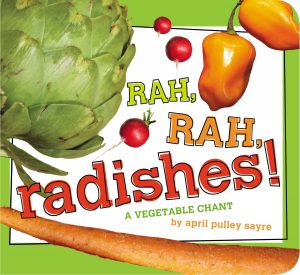 foods are introduced — including kohlrabi, rutabagas, tamarillos, kiwano, rambutan, mung beans and more. The books provide possibilities for rich discussions on a variety of plant-based culturally diverse foods. Additionally, some photographs feature foods labeled in languages other than English. Each book also includes an author’s end note with further nutritional facts, tips for those who might have allergies, and links to additional information on Sayre’s website at aprilsayre.com. Recommended for pre-K and primary grades.
foods are introduced — including kohlrabi, rutabagas, tamarillos, kiwano, rambutan, mung beans and more. The books provide possibilities for rich discussions on a variety of plant-based culturally diverse foods. Additionally, some photographs feature foods labeled in languages other than English. Each book also includes an author’s end note with further nutritional facts, tips for those who might have allergies, and links to additional information on Sayre’s website at aprilsayre.com. Recommended for pre-K and primary grades.
Bread, Bread, Bread by Ann Morris, Photographs by Ken Heyman (1989).
This informational text examines how bread is enjoyed throughout the world. The photographs are particularly appealing and an index in the back of the picture book links each photograph to the country in which it was taken: for example, a photo taken in India with the index comment, “This Sikh family in Bombay use chapattis, a kind of unleavened wheat bread, to soak up their egg. In Indian tradition, it is good manners to eat with your fingers” (p. 30). 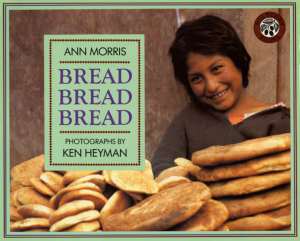 Although the book has great potential for classroom sharing and discussion, it is important to note that teachers should discuss the presence of moralizing words including how “bread is good for you,” which might not be true for those with certain food allergies or medical conditions. Additionally, the book does feature one photograph where an Italian man seated beside a cart of bread is smoking a cigarette. Overall, though, the book’s global perspectives on shared appreciation of food would help students connect across cultures. Recommended for pre-K and primary grades.
Although the book has great potential for classroom sharing and discussion, it is important to note that teachers should discuss the presence of moralizing words including how “bread is good for you,” which might not be true for those with certain food allergies or medical conditions. Additionally, the book does feature one photograph where an Italian man seated beside a cart of bread is smoking a cigarette. Overall, though, the book’s global perspectives on shared appreciation of food would help students connect across cultures. Recommended for pre-K and primary grades.
My Food, Your Food by Lisa Bullard, Illustrated by Christine Schneider (2015). This concept book is part of the Alike and Different Series by Cloverleaf Books, which explore a variety of everyday events and items, examining ways in which people and cultures are both similar, and unique. 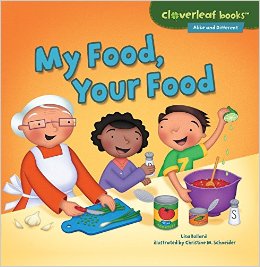 In addition to sharing the story of Manuel and his classroom’s “food week” unit, the book features interactive questions throughout that facilitate classroom discussions or teacher-led thinkalouds and reflections, including, “Does your family have a favorite dinner?” and “What parts of the world does your family come from? Do they like to eat any special foods from those places?” and “Do you help your family make meals?” This book links food and meals to culture, geography, family, and belonging. It would prompt rich discussion and text-to-self connections for readers. It also features strong nonfiction text features and models expository writing. Recommended for elementary grades.
In addition to sharing the story of Manuel and his classroom’s “food week” unit, the book features interactive questions throughout that facilitate classroom discussions or teacher-led thinkalouds and reflections, including, “Does your family have a favorite dinner?” and “What parts of the world does your family come from? Do they like to eat any special foods from those places?” and “Do you help your family make meals?” This book links food and meals to culture, geography, family, and belonging. It would prompt rich discussion and text-to-self connections for readers. It also features strong nonfiction text features and models expository writing. Recommended for elementary grades.
Down to Earth: How Kids Help Feed the World by Nikkie Tate (2013).
This book features farming and food production across the globe, with specific focus on how children contribute to growing and harvesting a variety of foods. The text models children actively “doing.” 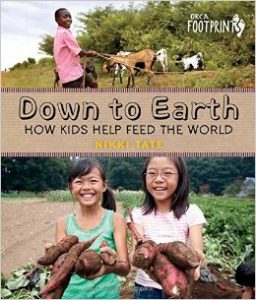 Organic farming, genetic diversity, animal welfare, and food distribution are described as well as illustrated with photographs featuring children from diverse locations around the world. The text also connects food and food production to science. Nonfiction text features including “food fact” pull quotes, sidebars, and end-note resources add to the book’s appeal. Recommended for upper elementary and middle school.
Organic farming, genetic diversity, animal welfare, and food distribution are described as well as illustrated with photographs featuring children from diverse locations around the world. The text also connects food and food production to science. Nonfiction text features including “food fact” pull quotes, sidebars, and end-note resources add to the book’s appeal. Recommended for upper elementary and middle school.
What the World Eats by Faith D’Aluisio, Photographed by Peter Menzel (2008).
Twenty-five families in twenty-one countries are featured in the young adult version of Menzel’s well known photo essay book Hungry Planet. The young adult version features a sample of portraits of families photographed with the food they would typically eat in one week. 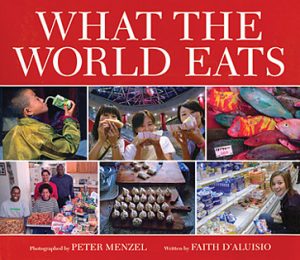 The book is highly visual but uses text wisely to highlight food availability, cultural influences, and economic disparities. Middle school and high school students could use this text as reference material, and it would also be a dynamic choice for teacher-led mini lessons examining the cultural and global influences on nutrition and diet. Recommended for middle school and high school.
The book is highly visual but uses text wisely to highlight food availability, cultural influences, and economic disparities. Middle school and high school students could use this text as reference material, and it would also be a dynamic choice for teacher-led mini lessons examining the cultural and global influences on nutrition and diet. Recommended for middle school and high school.
Dear Tomato: An International Crop of Food and Agriculture Poems, Edited by Carol-Ann Hoyte, Photography by Norie Wasserman (2015).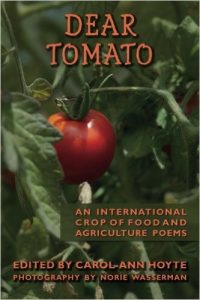
Food issues can also be highlighted in poetic form. This collection feature
s a variety of poetic forms including haiku, acrostic, free verse, quatrains, and more. Topics include lighthearted poems about picky eaters but also important social justice-oriented writings on farmworkers, food banks, and fair wages. The poems invite response, discussion, and might serve as mentor texts for young poets as well. Recommended for all ages, dependent on poem choice.
Conclusion
Choosing quality literature through a critical and cultural lens can open up powerful spaces in the classroom for examining how food and nutrition impact our lives and the lives of others across the globe. Well-chosen texts, partnered with critical pedagogy practices and an informed and holistic approach to nutrition-based education allow children to understand and embrace a variety of approaches to health and wellbeing.
References
CDC, 2014.http://www.ascd.org/ASCD/pdf/siteASCD/publications/wholechild/wscc-a-collaborative-approach.pdf
Dudley, D.A., Cotton, W.G., and Peralta, L.R. (2015). Teaching approaches and strategies that that promote healthy eating in primary school children: A systematic review and meta-analysis. International Journal of Behavioral Nutrition and Physical Activity, 12(28), online.
Eliassen, E.K. (2011). The impact of teachers and families on young children’s eating habits. Young Children, March, 84-89.
Gregory, J.,Paxton, S. & Brozovic, A. (2010). Maternal feeding practices, child eating behavior and body mass index in preschool aged children: A prospective analysis. The International Journal of Behavioral Nutrition and Physical Activity, 7: 55–65.
IOM (Institute of Medicine). (2013). Nutrition education in the K-12 curriculum: The role of national standards: Workshop summary. Washington, DC: The National Academies Press.
Joint Committee on National Health Education Standards. (2007). National Health Education Standards, Second Edition: Achieving Excellence. Washington, D.C.: The American Cancer Society. Retrieved from : http://www.shapeamerica.org/standards/health/
Lee, A. (2009). Evidence for a holistic approach to promoting health and improving health literacy. Applied Health Economics and Health Policy, 7(1), 11-17.
Liska Carger, C., Conklin, S. & Falk-Ross, F. (2002). Literature for life: Teaching health literacy with picture books and novels. Books Links, 12(2).
Matheson, D., Spranger, K. & Saxe, A. (2002). Preschool children’s perceptions of food and their food experiences. Journal of Nutrition Education and Behavior, 34 (2): 85–92.
Tileston, D.W. & Darling, S.K. (2008). Why culture counts: Teaching children of poverty. Bloomington, IN: Solution Tree Press. USDA (2010).
http://www.fns.usda.gov/school-meals/nutrition-standards-school-meals
Natalie K. DeWitt is an Assistant Professor in the Division of Health and Exercise Science at Western Oregon University.
Marie A. LeJeune is an Associate Professor and Undergraduate Program Coordinator in the Division of Teacher Education at Western Oregon University.
WOW Stories, Volume V, Issue 1 by Worlds of Words is licensed under a Creative Commons Attribution-NonCommercial-ShareAlike 4.0 International License.
Based on a work at wowlit.org/on-line-publications/stories/v1.
